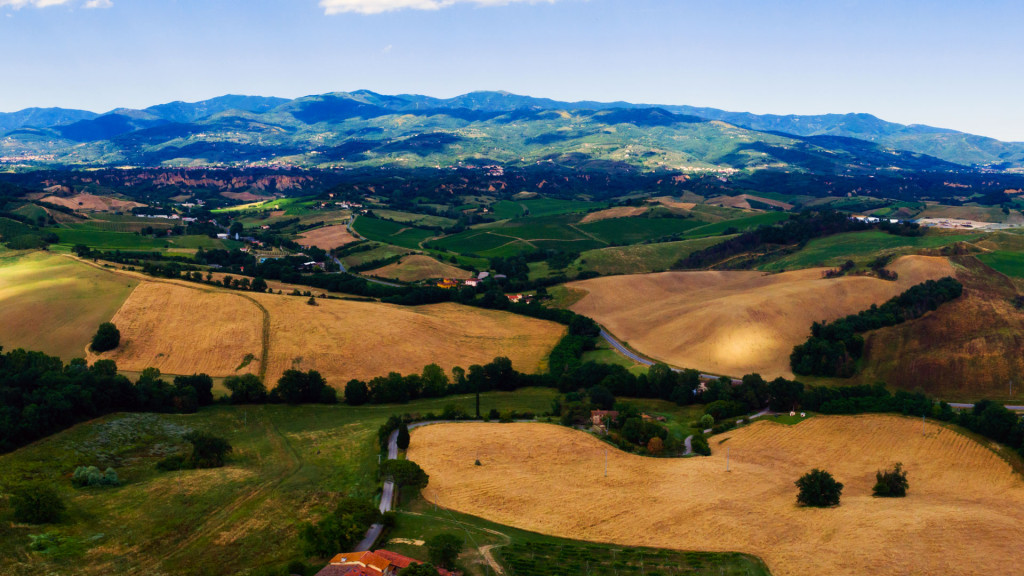The Four Valleys Around Arezzo, Filled with History, Culture, and Wonders Both Natural and Architectural, Beckon to be Explored
These valleys include the Casentino, Val di Chiana, Val Tiberina, and Valdarno. Continue reading this brief guide on the Arezzo territory, fuel your interest, and venture into these enchanting places!
The Casentino: A Jewel Among the Four Valleys
In the heart of Tuscany, north of Arezzo, lies the Casentino Valley, rich in invaluable historical and natural jewels. This paradise boasts landscapes ranging from snow-covered mountains in winter to ancient bastions, refuges of the people in medieval and modern times. The famous Casentino Forests National Park, internationally recognized and appreciated, calls nature lovers into its woods, which tell stories and legends. Dante Alighieri, the great poet, spent emblematic phases of his life here, shaping parts of the Divine Comedy and fighting in the Battle of Campaldino. Finally, the historic town of Poppi, dominated by the majestic Castle of the Conti Guidi, represents a precious reflection of the tradition and cultural evolution of the entire area.
Insights into the Casentino Valley
The Hermitage of Camaldoli, founded by Saint Romuald, represents an oasis of serenity and spirituality, hidden among enveloping woods. The lands of Pratovecchio and Stia reveal the legacy of the Conti Guidi in the Castle of Romena and the fascinating Church of San Pietro. Stia also hosts the Wool Art Museum, highlighting the distinctive woolen tradition of the Casentino. Soci, near Bibbiena, stands out for the production of the famous Casentino Cloth. But the Casentino is not just history: its traditional cuisine offers delights and D.O.P. products like the Cetica potato and the unique flavors of the Gray pig. Visiting the Casentino means immersing oneself in the essence of a genuine and unaltered Tuscany.
Discovering the Four Valleys: Exploring Val di Chiana and Its Treasures
Located south of Arezzo, the Val di Chiana represents a pearl of Tuscany, offering breathtaking landscapes and picturesque villages. The Canale Maestro della Chiana, built in 1338, marks its boundaries. Cortona, anciently known as Curtun by the Etruscans, hosts important archaeological sites and the acclaimed Diocesan Museum with art masterpieces. Walking through the streets of its center is a memorable adventure. In Castiglion Fiorentino, one breathes a medieval air, highlighted by the Church of San Francesco and the Vasari Loggia. The Piazzale del Cassero with its historic fortress cannot be ignored.
Culinary Delights and Local Customs
Monte San Savino has distinguished itself by earning the title of “Best Porchetta in Italy” in 2022, an honor that follows a previous record established in the Guinness World Records in 2004. Tasting such a delight against the backdrop of the Hanging Gardens of the Palazzo del Comune is an unforgettable experience. In the heart of Civitella in Val di Chiana, tradition and leisure unite through the Museum of Memory and the “Sarapino” event. This festival, inspired by the Arezzo Saracen Joust, is a time of celebration where competitors engage on Piaggio Apis. For those wishing a complete tour of Val di Chiana, Gargonza Castle and Lake Trasimeno are must-visit destinations.
Artistic and Historical Gems in Val Tiberina: The Journey Continues
The Val Tiberina is a treasure trove of historical and artistic wonders. Sansepolcro, with a past extending back to 934 A.D., has roots tied to a divine revelation received by Arcano and Egidio. In the town, one can admire the Cathedral with the exquisite Altarpiece by Perugino and walk among ancient buildings like Palazzo Ducci. Anghiari, recognized among the Most Beautiful Villages of Italy, remains etched in history for the Battle of 1440. This village offers spectacular views, such as those from the “Gian Franco Vené” Belvedere.
Journeys Through Art and Spirituality in Valtiberina
Caprese Michelangelo is known worldwide as the birthplace of Michelangelo Buonarroti. It houses the Michelangelo Birthplace Museum, located in the Castle of Caprese. Nearby, a church witnessed the baptism of the Renaissance master. Monterchi, though small, preserves masterpieces like Piero della Francesca’s “Madonna del Parto.” Valtiberina also presents jewels of faith, such as the hermitage of Montecasale, established by Saint Francis of Assisi, and the hermitage of Cerbaiolo, a former Benedictine monastery, now Franciscan, standing near Lake Montedoglio, evoking therefore the Verna Hermitage in the Casentino.
At the End of our Journey: Historical Treasures and Natural Beauties of the Valdarno
Situated between Arezzo and Florence, the Valdarno stands out for its ancient villages and spectacular views between the peaks of the Pratomagno and the rolling hills of Chianti. The Sammezzano Castle, exceptional in Tuscany for its Moorish-Oriental style, dates back to 1605. Redesigned in the 19th century, today it amazes visitors with its vivid frescoes and extensive gardens. The Valdarno also hosts wonders like the Abbey of San Giovanni Gualberto in Vallombrosa, surrounded by forests that seem lifted from an enchanted tale. The Bandella Nature Reserve, lastly, offers exciting routes through the biological riches of the River Arno.
Historical Gems and Cultural Heritage of the Valdarno
San Giovanni Valdarno, created by Arnolfo di Cambio, houses the Palazzo d’Arnolfo and the Basilica of Santa Maria delle Grazie. In Montevarchi, among the historic streets, one finds the Palazzo del Podestà and the Collegiate Church of San Lorenzo, while the Paleontological Museum exhibits ancient fossils, including the Elephas Meridionalis. Loro Ciuffenna boasts the oldest water mill in the region. Il Borro, renovated by the Ferragamos, has established itself as a top tourist destination. And then there’s Figline Valdarno, with its Collegiate Church, the Serristori Loggias, and the Garibaldi Theatre. Exploring the Valdarno equals therefore to immerse in a blend of history, creativity, and landscapes.

